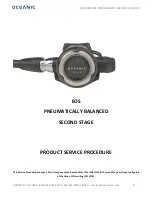
© Ultrafast Systems LLC /Vernier Software & Technology
19
Setting [A]
0
as the initial concentration of A, the integrated form of this differential rate equation is
given as
0
[ ] [ ] exp(
)
A
A
kt
Equation 10
which shows us that the concentration of A decreases as an exponential function of time. The shape of
the decrease of [A] curve in the above Figure 5 is exponential in time. Since the argument of the
exponential term must be dimensionless, it is clear that the units of
k
, the first order rate constant, are
time
-1
, and conventionally, time is measured in seconds, or sub-multiples of seconds such as ms, µs, or
ns.
At the half-life point,
50%
0
[ ]
0.5[ ]
A
A
and
1/ 2
exp(
) 1/ 2
kt
,
whence
1/ 2
ln 2 /
0.693 /
t
k
k
and a measurement of
t
1/2
leads to the rate constant.
The lifetime of a reaction, usually written as
,
is defined as the inverse of the rate constant,
1/
k
.
Thus Equation 10 can be written as
0
[ ] [ ] exp( / )
A
A
t
Equation
11
and at t =
,
0
0
[ ] [ ] exp( 1) 0.368[ ]
A
A
A
or, at the life-time point, the concentration of A has fallen to 36.8% (about 37%) of its initial value.
Note that in processes that are first order overall, the half life and the life time are independent of
time and initial concentration.
So far we have considered only the reaction that can be written
A
products
This implies that we are considering the spontaneous conversion of some compound into another,
chemically distinct, species. Such a process could be the spontaneous decay of an electronically excited
state of a molecule that has been generated by the absorption of photons (see Section 6.3). In this case
the product(s) could be the original ground state of the molecule, or an isomer thereof (cis-trans
photoisomerization). Such reactions are termed unimolecular because there is only one molecule
involved. Such reactions will show first order kinetics overall.
Now let us consider the elementary process
A B
products
Clearly this is now bimolecular because it requires a molecule of A and a molecule of B to react
together. At first sight, we would expect this process to show second order kinetics overall, but, as we
shall see, the order actually observed in an experiment will be determined by the reaction conditions.
















































